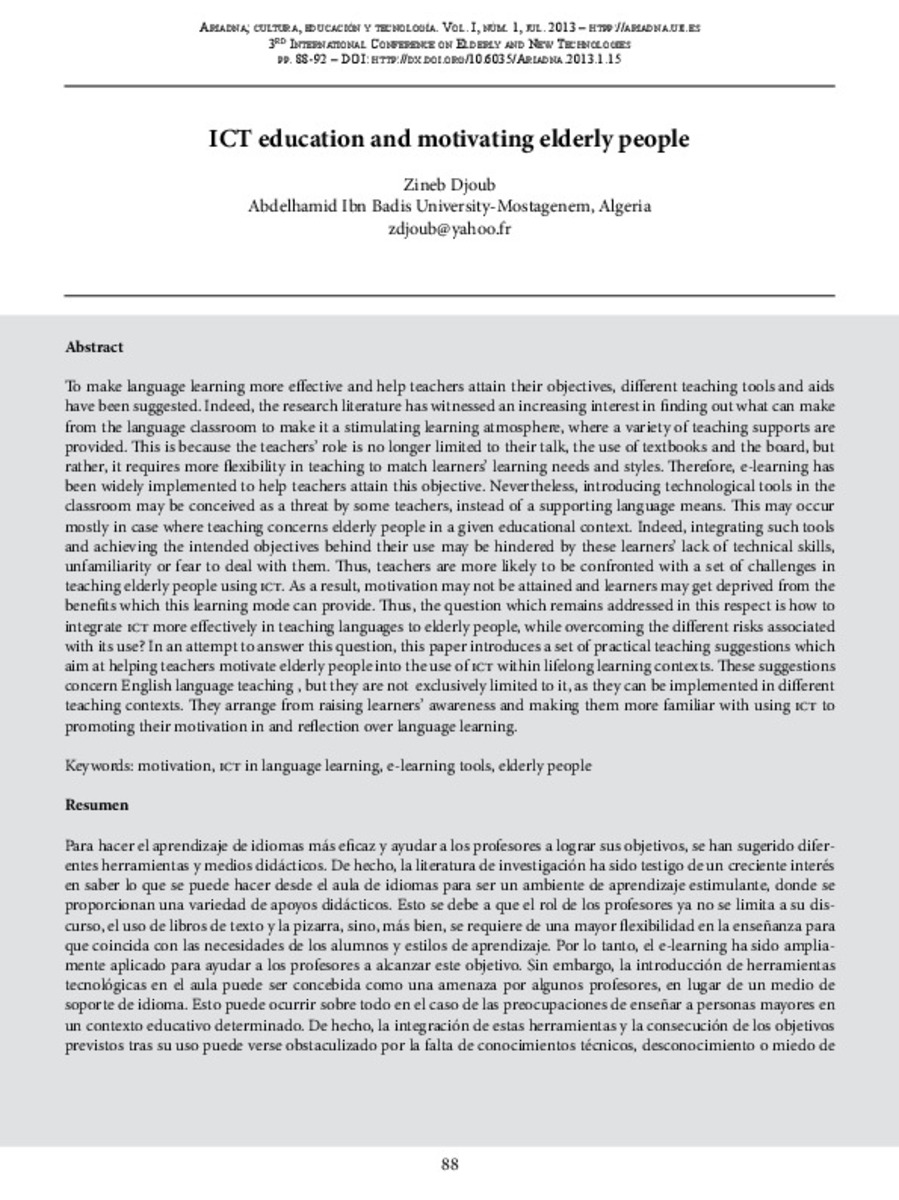Mostrar el registro sencillo del ítem
ICT education and motivating elderly people
| dc.contributor.author | Djoub, Zineb | |
| dc.date.accessioned | 2014-02-12T12:11:54Z | |
| dc.date.available | 2014-02-12T12:11:54Z | |
| dc.date.issued | 2013-07 | |
| dc.identifier.citation | Djoub, Zineb .ICT education and motivating elderly people.Ariadna, 2013, vol. 1_núm 1, p.88-92 | ca_CA |
| dc.identifier.issn | 2340-7719 | |
| dc.identifier.uri | http://hdl.handle.net/10234/83327 | |
| dc.description | 3rd International Conference on the Elderly and New Technologies. III Jornadas Internacionales de Mayores y Nuevas Tecnologías. | ca_CA |
| dc.description.abstract | To make language learning more effective and help teachers attain their objectives, different teaching tools and aids have been suggested. Indeed, the research literature has witnessed an increasing interest in finding out what can make from the language classroom to make it a stimulating learning atmosphere, where a variety of teaching supports are provided. This is because the teachers’ role is no longer limited to their talk, the use of textbooks and the board, but rather, it requires more flexibility in teaching to match learners’ learning needs and styles. Therefore, e-learning has been widely implemented to help teachers attain this objective. Nevertheless, introducing technological tools in the classroom may be conceived as a threat by some teachers, instead of a supporting language means. This may occur mostly in case where teaching concerns elderly people in a given educational context. Indeed, integrating such tools and achieving the intended objectives behind their use may be hindered by these learners’ lack of technical skills, unfamiliarity or fear to deal with them. Thus, teachers are more likely to be confronted with a set of challenges in teaching elderly people using ict. As a result, motivation may not be attained and learners may get deprived from the benefits which this learning mode can provide. Thus, the question which remains addressed in this respect is how to integrate ict more effectively in teaching languages to elderly people, while overcoming the different risks associated with its use? In an attempt to answer this question, this paper introduces a set of practical teaching suggestions which aim at helping teachers motivate elderly people into the use of ict within lifelong learning contexts. These suggestions concern English language teaching , but they are not exclusively limited to it, as they can be implemented in different teaching contexts. They arrange from raising learners’ awareness and making them more familiar with using ict to promoting their motivation in and reflection over language learning. | ca_CA |
| dc.description.abstract | Para hacer el aprendizaje de idiomas más eficaz y ayudar a los profesores a lograr sus objetivos, se han sugerido diferentes herramientas y medios didácticos. De hecho, la literatura de investigación ha sido testigo de un creciente interés en saber lo que se puede hacer desde el aula de idiomas para ser un ambiente de aprendizaje estimulante, donde se proporcionan una variedad de apoyos didácticos. Esto se debe a que el rol de los profesores ya no se limita a su discurso, el uso de libros de texto y la pizarra, sino, más bien, se requiere de una mayor flexibilidad en la enseñanza para que coincida con las necesidades de los alumnos y estilos de aprendizaje. Por lo tanto, el e-learning ha sido ampliamente aplicado para ayudar a los profesores a alcanzar este objetivo. Sin embargo, la introducción de herramientas tecnológicas en el aula puede ser concebida como una amenaza por algunos profesores, en lugar de un medio de soporte de idioma. Esto puede ocurrir sobre todo en el caso de las preocupaciones de enseñar a personas mayores en un contexto educativo determinado. De hecho, la integración de estas herramientas y la consecución de los objetivos previstos tras su uso puede verse obstaculizado por la falta de conocimientos técnicos, desconocimiento o miedo de tratar con ellos por parte de estos alumnos. Por lo tanto, los profesores tienen más probabilidades de ser confrontados con una serie de desafíos en la enseñanza de personas mayores que utilizan las tic. Como resultado, la motivación no puede ser alcanzada y los alumnos pueden desfavorecerse de los beneficios que este modo de aprendizaje puede proporcionar. Por lo tanto, la pregunta que sigue siendo tratada en este sentido es ¿cómo integrar las tic con mayor eficacia en la enseñanza de idiomas para las personas mayores, mientras se superan los distintos riesgos asociados con su uso? En el intento de responder a esta pregunta, este artículo presenta un conjunto de sugerencias para la enseñanza práctica que tiene como objetivo ayudar a los profesores a motivar a las personas mayores en el uso de las tic en el contexto del aprendizaje permanente. Estas recomendaciones se aplican en la enseñanza del idioma inglés, pero no se limitan exclusivamente a este idioma, ya que se pueden aplicar en diferentes contextos de enseñanza. Se organiza la sensibilización de alumnos y la familiarización con el uso de las tic para la promoción de la motivación y la reflexión sobre el aprendizaje de idiomas. | ca_CA |
| dc.format.extent | 5 p. | ca_CA |
| dc.format.mimetype | application/pdf | ca_CA |
| dc.language.iso | eng | ca_CA |
| dc.publisher | Universitat per a Majors de la Universitat Jaume I | ca_CA |
| dc.rights | Attribution-NonCommercial-NoDerivs 4.0 Spain | ca_CA |
| dc.rights.uri | http://creativecommons.org/licenses/by-nc-nd/4.0/ | |
| dc.subject | Motivation | ca_CA |
| dc.subject | Ict in language learning | ca_CA |
| dc.subject | E-learning tools | ca_CA |
| dc.subject | Elderly people | ca_CA |
| dc.subject | Motivación | ca_CA |
| dc.subject | Las tic en el aprendizaje de idiomas | ca_CA |
| dc.subject | herramientas de e-learning | ca_CA |
| dc.subject | Persona mayor | ca_CA |
| dc.subject.other | Integració econòmica | ca_CA |
| dc.title | ICT education and motivating elderly people | ca_CA |
| dc.type | info:eu-repo/semantics/article | ca_CA |
| dc.identifier.doi | http://dx.doi.org/10.6035/Ariadna.2013.1.15 | |
| dc.rights.accessRights | info:eu-repo/semantics/openAccess | ca_CA |








